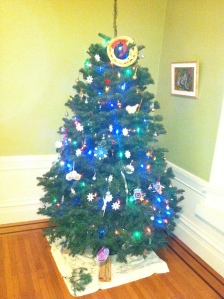
One of these things is not like the other.
Recently I visited San Francisco’s waste management center. My university is a shared governance institution (often more in name than in deed) so I am expected to do service. One of my appointments is to the campus-wide Sustainability Committee. I also had to pick a sub-committee, and I asked for Transportation, because I am all about the bikes. But everybody wanted Transportation and I’m pretty junior, so they put me on Zero Waste instead. Anyway, all members of the Zero Waste sub-committee were asked to take a tour of San Francisco’s waste management centers. My first field trip!
San Francisco’s waste management is run by Recology, one of the country’s largest employee-owned cooperatives. San Francisco diverts 80% of its waste from landfills, better than any other municipality in the US and most countries in the world. The city’s goal is to be zero-waste by 2020. The university, which is Recology’s 2nd largest account, is hanging in at 63%. San Francisco has reached this point by implementing aggressive recycling efforts (including prosecuting recycling poachers), creating a hugely successful composting program (in part by instituting a $1,000 minimum fine for throwing compostables in landfill bins), and to a certain extent, by taking advantage of a quirk in how diversion rates are calculated (albeit no more than other cities and countries do).

This is some of the art made from found materials at the transfer station.
Our tour was absolutely fascinating. Recology does not allow photos of most of its operations, because there are apparently trade secrets in the world of waste management. I realize that the dump is not a traditional tourist attraction, but if you happen to be in San Francisco, it is definitely worth checking out.
Our visit started at the business office, where we picked up hard hats and met the sales staff. “I’m Maria,” said one woman who looked like a supermodel heading down the catwalk. “I handle the city accounts, and I’m a dumpster diver.” From there we headed to the recycling transfer station.
If you have seen Toy Story 3, the recycling transfer station will feel somewhat familiar. Trucks enter the building (1/3 of its power is generated by solar panels on the roof, because that is how Recology rolls) and dump recyclables onto the floor. From there they are moved by giant front loaders onto even more giant conveyer belts that sort out paper, plastics, metal and glass as they lift materials to the second floor. The Toy Story 3 feeling comes both from being surrounded by garbage and from feeling like a tiny mote in a giant machine. The amount of material being moved through the transfer station is simply mind-boggling. It was difficult to grasp its scale. On the second floor, the materials the machines could not handle are hand-sorted. Watching this process made me despair for humanity, as my fellow San Francisco residents seem unable to grasp the concept of what belongs in the recycling. Dozens of workers attempted to pick out plastic bags, clothing, plastic bottles of motor oil, ad infinitum, from paper destined for bundling and eventual recycling. It was impossible. They aim for 90% appropriate materials in the bales, we were told. That should be easier than it is. The relentless efforts of the hundreds of garbage-snatching seagulls didn’t help matters either.

Is artistic reuse recycling, upcycling, or something else entirely?
Recycling is a tricky concept. Some things are recycled and some are only kind of recycled. Glass and metal containers and shards are melted down and turned into more glass and metal containers. Concrete is smashed into sand and turned into more concrete. Although the process is energy intensive, these are closed loops. These products are recycled. Paper is kind of recycled. High quality paper, like office paper, is usually turned into low-quality paper, like paper bags. Low-quality paper is turned into even lower-quality paper, like tissues and toilet paper. The tissues can go into the compost, but the toilet paper goes to landfill by way of the sewer system. The more non-paper waste that gets mixed into the paper, the less likely it can be reclaimed for higher-quality recycled paper. Rigid plastic is down-cycled. Assuming it isn’t thrown away outright, it gets one more use; bottles turn into plastic lumber or carpet or fleece, but once these materials wear out, they all go to the landfill. And soft plastics all go directly to the landfill, although only after Recology workers spend six hours out of every 24 picking plastic bags out of the recycling machinery. Less than thirty minutes into the tour, I was completely convinced that I should never buy another item wrapped in soft plastic. This is surprisingly hard, even in San Francisco.
The university facilities representative leading our group was less sanguine about San Francisco’s 80% diversion rate. Diversion rates are calculated by weight, and San Francisco recycles a lot of concrete. By volume, the endless sea of plastic is a much bigger problem, and landfills, of course, are packed by size and not by weight. Other universities in California also claim diversion rates of 80% but only, he said, “because they tear down buildings or repave parking lots every year.” Construction and demolition, as well as aggressive composting at San Francisco’s many restaurants and parks, boosts the calculated diversion rate. He estimated, glumly, that San Francisco residents are recycling and composting at most 40% of the waste that they could. And that this is the best rate in the country.

More art from reclaimed waste
From the recycling transfer station, we headed to the main facility, where household waste, compost and landfill waste are packed up for their eventual destinations. Recology served us a nice lunch on plates and silver diverted from landfill, showed us an upbeat little movie, and answered questions. I was not brazen enough to ask whether the food was dumpster-dived, but after seeing what people throw away in this city, I would not be surprised if it was. We had lots of questions. I learned that you can recycle (okay, down-cycle) dental floss containers because they are rigid plastic; removing the metal cutter is nice but not necessary. Dental floss itself, however, is uniformly made of plastic and messes with sorting machinery and should always go in the landfill bin. Toothpaste tubes, tetrapaks: landfill. The soft plastics “recycling” bins at grocery stores that supposedly send plastic bags to be turned into park benches? Our facilities representative reported that almost no store will say where they’re actually going, so they’re probably being sent straight to the landfill.
The most hated word at Recology turned out to be “biodegradable.” Nearly everything is biodegradable eventually, they said. But people think that means it can be composted. It cannot. “Compostable” is a legally binding term in the state of California; if an item says it is compostable and it’s not, the state will levy massive fines. Biodegradable is a weasel word intended to sidestep the law. So “biodegradable” materials and bioplastics: landfill. The plastic keeps the biological material from composting, and the biological material contaminates the plastic. That was depressing.

More art from the gallery
Much less depressing was the visit to the Artist in Residence program, where artists are sponsored to create projects out of whatever they can find on site. Much of the art was wildly impressive, and there are regular shows where it can be viewed, as well as an outdoor sculpture garden. Many of the other sites showed where visitors came to drop off household waste sorted through it; construction debris is sorted, furniture is donated to thrift stores, electronic waste and batteries are sorted by type. Recology was also pioneering Styrofoam recycling; clean packing materials were compressed into thin, heavy sticks that could be used for things like crown molding. The process is hopelessly expensive and energy-intensive so it’s more of a demonstration project than a feasible way to handle waste, but it was interesting. The inevitable seagulls were controlled by an on-site falconer who kept four hawks circling all day. Recology had tried bottle rockets, netting and dogs, but the hawks were the most effective. We did not get to tour the compost transfer station, probably the biggest success of the program; San Francisco’s compost is used by California wineries and farms. And I got to take some compost home to show my kids what putting food waste in the compost bin, which they do diligently, really meant. They were completely floored.

Our old seat cushion went to the Pit. Is there a better alternative?
Our last stop was The Pit. Everything that goes into a black bin in San Francisco is dumped, unsorted, into The Pit, shoveled into tractor-trailers, and trucked to the landfill. The Pit is huge. It runs 24 hours a day and seven days a week. There is a smell. Trucks enter at the top level and drop their loads. The sounds of breaking glass and the efforts of occasional seagulls to snatch food make it pretty clear that a lot of what’s in The Pit could be recycled or composted (efforts to assess it suggest that two-thirds of what’s in The Pit could be diverted). Bulldozers shovel the waste into waiting tractor-trailers below. The process never stops. It is difficult to describe the feeling of watching massive piles of trash build and be shoveled away, endlessly. It turns out that material in landfills does not biodegrade. Everything that goes into the landfill is forever. I will never look at a garbage can the same way again.

This is how we shop now.
I see now why were asked, as part of our service on the Zero Waste sub-committee, to visit Recology. This is the best that the United States currently has to offer in terms of waste management, and that was sobering. At home, post-tour, we are now uncompromising in using cloth produce bags (we had always used cloth grocery bags) at the farmer’s market and we don’t shop at Trader Joe’s much anymore, because there’s almost nothing to buy there that’s not wrapped in plastic. We now buy milk and yogurt in glass, and everything else in bulk. But mostly, we are buying less, because everything we buy must eventually be handled somehow, and packaging is not free. It is probably not a coincidence that this month’s grocery bill is half of last month’s.
I am familiar with life-changing experiences by now, and this one didn’t require a trip to Copenhagen. I only had to ride across town.
But I promised to tell how to get a bike for free. The answer is to work for Recology. One of the tour guides mentioned that he never had to take his own bike to site visits and lock it outside, because he could always pick out a nice bike from the garbage. Recology workers never have to worry about San Francisco’s rampant bike theft. He admitted that the last bike he picked up was better than his commuter bike, “way more gears for the hills.” It’s entirely possible that anyone could show up at the dump and ask for a bike.

This is our refrigerator post-tour. We are trying harder. (The glass jars are sold by Cole Hardware in San Francisco for thrift store prices, luckily for us.)
At Recology they suggest people stop calling the things in bins “garbage.” A better word for the many unnecessary things we throw away is “waste.” And a free bike is the least of it.
































